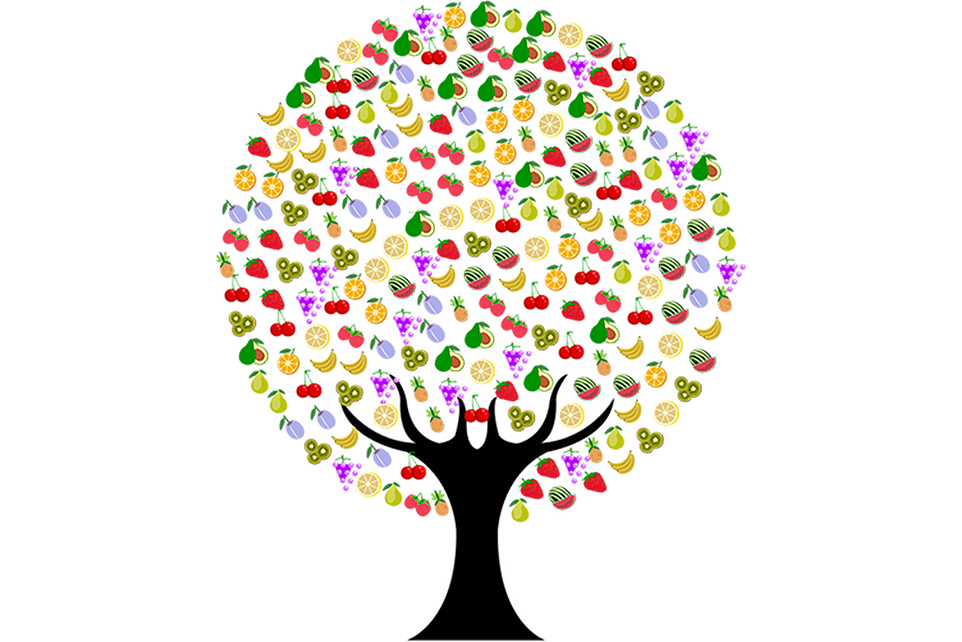Science from the field to the fork
This article, the third in our series, Science from the Field to the Fork, has become a regular feature in the Les vergers Boiron magazine and our newsletter. This series, supervised by Corinne Tisné, Project Head, Research and Development Les vergers Boiron, is designed to heighten awareness on the link between science, agronomy, growing practices and the techniques used for the transformation of fruits, and how these factors impact gastronomy, pastry-making and mixology.
We began this series with an article on the notion of the terroir, followed by the reproduction of fruits. This time, we look at the complex makeup of fruits and their incredible variety worldwide.
No. 3 - THE DIFFERENT FORMS OF FRUIT
In our previous article, Everything you need to know about fruits, we saw that the fertilized flower becomes a fruit to nourish and protect the seeds, as well as to ensure the reproduction of the plant.
In nature, the ultimate reproductive goal of the fruit is to detach itself from the plant and to fall onto the soil, where it rots, enabling the seeds to sprout and to take root in a nearby location.
When the fruit is interrupted in its complete lifecycle, it is eaten by animals or gathered by human beings. Thus, in our conception of its nutritional function and in our everyday language, fruit generally refers to the plant organ that we eat for dessert.
However, if you talk to a botanist, he or she will explain that a fruit we consume may refer to its flesh, the seed itself or the surrounding parts or protection of the seeds. Let’s look at what fruits are made up of and how they evolve.
To begin with, just after fertilization, the outer lining of the ovary transforms itself to become the pericarp, which contains a seed or seeds. Starting from the inside of the fruit and going outwards, the following elements can be found in different proportions and forms:

- The seed or seeds
- The endocarp lignified or woody, such as the pit or stone
- The mesocarp is the flesh or the pulp
- The epicarp is the skin of the fruit.

If the mesocarp is full or contains reserves, the fruit is considered fleshy. This the case of drupes, where there is a single seed encased in a pit or stone (e.g. cherry, peach apricot). This is also the case for berries, where several pips are freely present in the pulp (e.g. grapes, redcurrants, oranges).
If the mesocarp is dry, without any pulp, then the fruit is known as a nut. These fruits can be in the form of pods, like peas, or siliques or siliqua, such as ‘money fruit’. It’s also possible to consume the pulp surrounding the seeds, as in the case of tamarin.
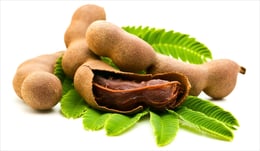 These fruits open up when they are ripe and free up the seeds.
These fruits open up when they are ripe and free up the seeds.
Strawberry fields forever!
Some other nuts or berries do not open up when ripe and form what are known as achenes. In the case of strawberries, it’s not the fruit that we consume and appreciate, but the carpophore, the flesh that bears the achenes, the small seeds on the surface of the berry. This flesh grows considerably and so, from a botanical standpoint, the achenes are the actual fruit! In fact, the part of the strawberry we consume is a false fruit!
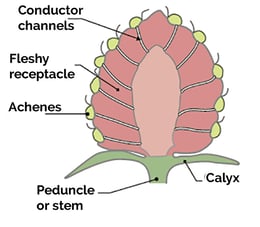
In the case of pineapples, we eat only the juicy flesh located below the skin, which nourishes the small fruits located in the scales on the surface, which we peel off. We also distinguish between complex fruits, such as blackberries or raspberries, which are made up of several drupes (or berries) that are clustered together.

Finally, there are complex fruits such as apples, where the botanical fruit itself is the core, while we eat the conceptacle, i.e. the part that previously bore the flower.
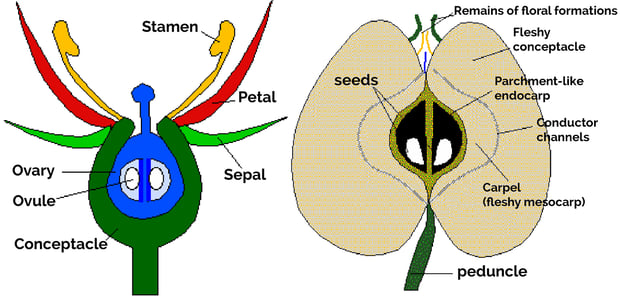
As we’ve seen, things aren’t as simple as they appear.
Fruits not only grace our gardens and nourish us, but also provide us with some food for thought. John F. Kennedy once famously said that “Forbidden fruit tastes sweet, but its aftertaste is bitter.” We also talk about bearing the fruit of our labor or our efforts or we refer to easy wins as “picking low-hanging fruit”. William Shakespeare put it, as one would expect, more poetically: “The weakest kind of fruit drops earliest to the ground”. We also talk about fruitful discussions or seeds for thought or seed money. So don’t run out of juice and, if you’re drinking (especially during the holidays), make sure you don’t get juiced!
Fruity fruits
Here’s some food for thought. Did you ever hear of the following fruits and do you know exactly what we eat in these plants?
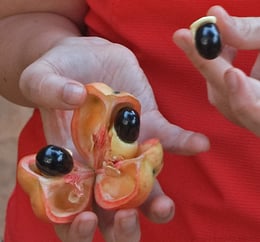 The yackee (also known as ackee, achee or ayee) is an emblematic Jamaican fruit. It is not completely edible: only the fleshy arilles (white fleshy parts) clinging to the seeds can be eaten. The rest of the plant and the seeds are in fact toxic! Also, the fruit must be harvested only when it has completely ripened, when it opens up naturally and is still fresh, but not yet mushy. Fruits that are not ripe enough or overripe are also dangerous. Even when ripe, the fruit can cause an ailment known as Jamaican vomiting and can also cause hypoglycemia. So be careful, but connoisseurs say it is a real treat!
The yackee (also known as ackee, achee or ayee) is an emblematic Jamaican fruit. It is not completely edible: only the fleshy arilles (white fleshy parts) clinging to the seeds can be eaten. The rest of the plant and the seeds are in fact toxic! Also, the fruit must be harvested only when it has completely ripened, when it opens up naturally and is still fresh, but not yet mushy. Fruits that are not ripe enough or overripe are also dangerous. Even when ripe, the fruit can cause an ailment known as Jamaican vomiting and can also cause hypoglycemia. So be careful, but connoisseurs say it is a real treat!
 Akebia quinate, also known as chocolate vine because of its aroma, grows in certain parts of China, Korea and Japan. When the fruit is ripe, akebia opens up naturally, revealing its irregularly positioned brownish seeds. The fleshy gelatinous parts, which are quite tasteless at first, offer a delicate sweet taste when ripe, with a juicy texture and a banana-like flavor, with hints of lychee and passion fruit for the best products. The outside shell is also edible but is bitter compared to the inside, and many people eat akebia fried.
Akebia quinate, also known as chocolate vine because of its aroma, grows in certain parts of China, Korea and Japan. When the fruit is ripe, akebia opens up naturally, revealing its irregularly positioned brownish seeds. The fleshy gelatinous parts, which are quite tasteless at first, offer a delicate sweet taste when ripe, with a juicy texture and a banana-like flavor, with hints of lychee and passion fruit for the best products. The outside shell is also edible but is bitter compared to the inside, and many people eat akebia fried.
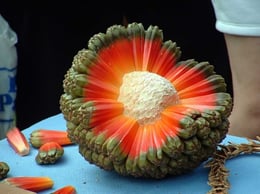 In Oceania or the Pacific basin, people eat multicolored prickly fruits, which look more like Pokémon’s than edible fruits. Before being husked, the hala fruit looks a bit like a big green pineapple. Once it’s opened, it reveals a big white core, to which are attached dozens of stems in various shades of yellow, orange or red. Its texture is a bit like a pineapple, but a bit chewier. It can also be transformed into a drink that involves drying the fruit to get a flour, which is then mixed with water. The leaves of the tree are used as herbs to flavor curries and jams.
In Oceania or the Pacific basin, people eat multicolored prickly fruits, which look more like Pokémon’s than edible fruits. Before being husked, the hala fruit looks a bit like a big green pineapple. Once it’s opened, it reveals a big white core, to which are attached dozens of stems in various shades of yellow, orange or red. Its texture is a bit like a pineapple, but a bit chewier. It can also be transformed into a drink that involves drying the fruit to get a flour, which is then mixed with water. The leaves of the tree are used as herbs to flavor curries and jams.
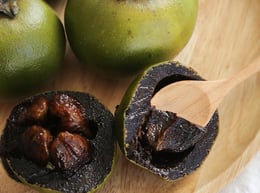 Let’s finish this tour of exotic fruits with the black sapota fruit, also known as sapodilla or American medlar.
Let’s finish this tour of exotic fruits with the black sapota fruit, also known as sapodilla or American medlar.
It seems it’s also known as chicken poop in certain Central American countries, Cuba and the Dominican Republic. It has a chocolaty flavor and color and is consumed in very different ways, mixed with milk or orange juice to intensify the cacao aromas, but is also eaten as a fruit. It is most commonly used in mousses or cakes instead of chocolate.
So, do any of these fruits tickle your fancy?

